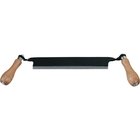I've now got a lot of thick green bowl blanks (apple, choke cherry, mulberry, hickory, oak, walnut, all from trees cut while dormant) that still have bark on one face surface, and I want to remove any loose or excess bark before turning (especially the choke cherry). Normally I'd just go at it with a chisel and mallet, but with the quantity of blanks I'm looking at, that'll get old really quick. I've seen some turners using air hammers with chisel bits, but before I go buy one, I'd like to find out if anyone has a better suggestion. What d'ya say?
-
December 2025 Turning Challenge: Single Tree! (click here for details) -
Congratulations to Bob Henrickson, People's Choice in the November 2025 Turning Challenge (click here for details) -
Congratulations to Guillaume Fontaine for "Old Tea Pot" being selected as Turning of the Week for December 15, 2025 (click here for details) -
Welcome new registering member. Your username must be your real First and Last name (for example: John Doe). "Screen names" and "handles" are not allowed and your registration will be deleted if you don't use your real name. Also, do not use all caps nor all lower case.
You are using an out of date browser. It may not display this or other websites correctly.
You should upgrade or use an alternative browser.
You should upgrade or use an alternative browser.
What's your preferred tool for excess bark removal before turning?
- Thread starter Ric Williams
- Start date
- Joined
- Apr 27, 2004
- Messages
- 9,304
- Likes
- 6,059
- Location
- Lakeland, Florida
- Website
- www.hockenberywoodturning.com
I've now got a lot of thick green bowl blanks (apple, choke cherry, mulberry, hickory, oak, walnut, all from trees cut while dormant) that still have bark on one face surface, and I want to remove any loose or excess bark before turning (especially the choke cherry). Normally I'd just go at it with a chisel and mallet, but with the quantity of blanks I'm looking at, that'll get old really quick. I've seen some turners using air hammers with chisel bits, but before I go buy one, I'd like to find out if anyone has a better suggestion. What d'ya say?
if I can’t pull it off with my fingers I leave it. I turn mostly wet wood. Many with Natural edge where I want the bark.
many blanks for cut rim bowls or even spindles will have some bark.
bark can fly off and can be a danger - stay out of the line of fire. Bark is not heavy so serious injury is unlikely.
cutting the bark successfully is dependent on your turning style, tools used, and how the cutting edge is presented to the wood.
these screen shots from a bowl demo show a typical 11-12” diameter blank prepared with a chainsaw an bandsaw from a half log. Two large sections of bark. 3rd photo I can’t pull the bark free,
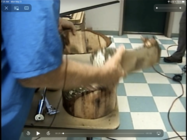
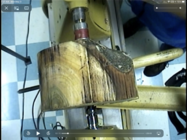
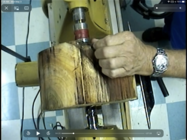
here is a shot of the initial roughing
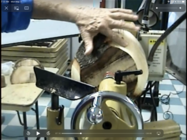
if the bark is exceptionally dirty I would take it off with a flat chisel. Tedious work but it saves bandsaw blades.
Last edited:
- Joined
- Apr 27, 2004
- Messages
- 9,304
- Likes
- 6,059
- Location
- Lakeland, Florida
- Website
- www.hockenberywoodturning.com
you might wish to see the demo of cutting the green bowl for drying.
screen shots above are from the video
the thread working with green wood is from demo.the
slides with an overview of wood, video of turning a green bowl for drying, video of returning a dried bowl.
 www.aawforum.org
www.aawforum.org
screen shots above are from the video
the thread working with green wood is from demo.the
slides with an overview of wood, video of turning a green bowl for drying, video of returning a dried bowl.
Working with green wood
The August 2015 AAW JOURNAL has great article by David Ellsworth on working with green wood. This is followed by 11 marvelous ways turners turned cracks into features. One of David's themes is that the deck is stacked against newer woodturners successfully working with wet wood. Might be a nice...
I’m the same Al. I use my fingers and sometimes a large flatblade screwdriver to remove the bark that comes off easily, then turn the rest off. Pieces do fly off and I have been hit by them but not injured. RPM is usually not high during initial roughing which gets most or all of it. It’s tough on tool edges but a turning tool is the fastest way to remove bark that is stuck on.
Most wood that I turn is dry.........if I can't get the bark off with my fingers, I use a small chisel and hammer.
For bark that agrees to come off, I use a 3" heavy scraper, like this, with a hammer:
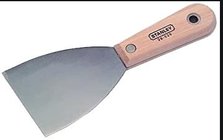
For bark that sticks tightly, I haven't found a good solution other than just turning it away with a bowl gouge. I tried an air chisel from Harbor Freight, but my air compressor doesn't have enough CFM for it to work well (I just have a small, and quiet, California Air Tools compressor.)

For bark that sticks tightly, I haven't found a good solution other than just turning it away with a bowl gouge. I tried an air chisel from Harbor Freight, but my air compressor doesn't have enough CFM for it to work well (I just have a small, and quiet, California Air Tools compressor.)
Roger Wiegand
Beta Tester
Bowl gouge. Not sure what the point of taking an extra step is.
If I need to put a face plate on the bark side I cut a square big enough to fit the round faceplate with a big chisel and mallet. Generally doesn't take but a few whacks to get a flat enough surface. If I think of it I do it with the chain saw if I'm knocking the corners off as well. Anything else just gets turned off later.
If I need to put a face plate on the bark side I cut a square big enough to fit the round faceplate with a big chisel and mallet. Generally doesn't take but a few whacks to get a flat enough surface. If I think of it I do it with the chain saw if I'm knocking the corners off as well. Anything else just gets turned off later.
Dave Landers
Beta Tester
I'm working through some walnut now that the bark is not really attached to the wood (due to something about how the tree died, I think). Since it's coming off anyway, I am removing most of it just so big chunks don't go flying off the lathe. Also, it's really dusty under the bark, so after removing the bark I am wire-brushing that off just to keep it out of the air.
I usually use a hatchet on bowl blanks, either to whack off all the bark, or to just chop thru a bit so the live center can get to the wood. Sometimes a chisel or a sturdy fixed-blade knife works better for prying off loose bark. For longer logs, I often use a draw knife.
I usually use a hatchet on bowl blanks, either to whack off all the bark, or to just chop thru a bit so the live center can get to the wood. Sometimes a chisel or a sturdy fixed-blade knife works better for prying off loose bark. For longer logs, I often use a draw knife.
That sounds like you have a lot of good material for natural edge bowls as long as you turn it before it starts to dry.
On a side note choke cherry does not get very large, however black cherry can get quite large and it is quite difficult to tell any difference between the fruits. The Audubon society guide lists choke cherry as up to 6" diameter and black cherry as up to 2 feet in diameter.
On a side note choke cherry does not get very large, however black cherry can get quite large and it is quite difficult to tell any difference between the fruits. The Audubon society guide lists choke cherry as up to 6" diameter and black cherry as up to 2 feet in diameter.
Well, other than cutting a flat on the outside of a half round section of a lot so I don't have the bark on the bottom of the bowl, I make sure to stand out of the line of fire, and turn it off. The Big Ugly tool, or any scraper, is excellent for removing bark as you turn with minimal dulling. I never turn at high speeds if there is bark on the wood.
robo hippy
robo hippy
I should have been more clear in my question. I'm mainly trying to get the stuff that's going to come flying off in roughing. If the best choice is to let it fly, then that's what I'll do. I was just trying to minimize how much debris I get hit with.
Let it fly, but stay out of the line of fire...face mask
Brian Horais
In Memoriam
With the log mounted on the lathe but NOT turning, a draw knife works well to cut/scrape off the layers of bark. You can remove a section and then rotate the log by hand and repeat. Put some friction on the shaft to keep it from turning easily (but remember to remove the friction when you are done) This removes most of the outer bark off to a point where you can finish removing it with a roughing gouge (with the lathe turning). I agree with Jeff, this job definitely demands a face mask to protect you from flying bark. Here's a generic image of a draw knife.I've now got a lot of thick green bowl blanks (apple, choke cherry, mulberry, hickory, oak, walnut, all from trees cut while dormant) that still have bark on one face surface, and I want to remove any loose or excess bark before turning (especially the choke cherry). Normally I'd just go at it with a chisel and mallet, but with the quantity of blanks I'm looking at, that'll get old really quick. I've seen some turners using air hammers with chisel bits, but before I go buy one, I'd like to find out if anyone has a better suggestion. What d'ya say?
Attachments
In addition to getting hit with chunks, one other reason to pull or chisel off the bark, is the gritty, tool-dulling debris that the bark contains. You can also then look for staining from nails, though most of the time these get identified by the 'tink' sound and subsequent cursing.
I should have been more clear in my question. I'm mainly trying to get the stuff that's going to come flying off in roughing. If the best choice is to let it fly, then that's what I'll do. I was just trying to minimize how much debris I get hit with.
A good way to stay out of the line of fire of bark, shavings, sap, unattached chunks of wood, etc, is to turn the outside of the bowl left handed. I.e. left hand on the handle of the gouge, right hand pressing the gouge against the tool rest.
At about the 3:25 point in this video, Glenn Lucas is turning left handed, showing his famous, send the shavings right into a dumpster technique.
If you turn left handed with an overhand grip on the gouge you can stand back even farther out of the line of fire. This is how I start most bowls. Once the shape is close to what I want, I switch to a normal, right handed grip for better control.
Last edited:
You already have the perfect machine, a lathe and a chisel. Why make it a manual situation?
That shouldn't be too hard since I'm left handed. Fortunately, when it comes to turning, I'm equally bad left or right handed.A good way to stay out of the line of fire of bark, shavings, sap, unattached chunks of wood, etc, is to turn the outside of the bowl left handed. I.e. left hand on the handle of the gouge, right hand pressing the gouge against the tool rest.
At about the 3:25 point in this video, Glenn Lucas is turning left handed, showing his famous, send the shavings right into a dumpster technique.View: https://www.youtube.com/watch?v=mc9vgICiIeU
If you turn left handed with an overhand grip on the gouge you can stand back even farther out of the line of fire. This is how I start most bowls. Once the shape is close to what I want, I switch to a normal, right handed grip for better control.
With the log mounted on the lathe but NOT turning, a draw knife works well to cut/scrape off the layers of bark. You can remove a section and then rotate the log by hand and repeat. Put some friction on the shaft to keep it from turning easily (but remember to remove the friction when you are done) This removes most of the outer bark off to a point where you can finish removing it with a roughing gouge (with the lathe turning). I agree with Jeff, this job definitely demands a face mask to protect you from flying bark. Here's a generic image of a draw knife.
I didn't think of using a draw knife, probably because I don't have one, but you've given me a good reason to get one! I don't turn without a substantial face mask on. I've had enough chunks of wood bounce off of mine to be convinced.
Hmm, never noticed that he turns the outside left handed. Kind of looks like a pull cut but he is standing on the other side of the tool... I really like his jig on the tailstock to mark the diameter of the tenon he will use. Also, never noticed that he is using some thing that looks like a pin chuck, but it looks like that face plate on the lathe has spikes on it so, that hole is more for centering, and the pins/spikes supply the drive.
I do prefer spring harvested trees. I don't do natural edge bowls very often and I never worry about keeping the bark on. The spring bark is not attached really tightly, but seldom comes flying off. If I have a tree that has been dead standing, or sitting around for a while in my log pile, those are the ones that have chunks that want to fly off when turning. Most of the time, since I know this from 'experience', I just stand out of the line of fire, which is some thing I do ALL the time anyway.
robo hippy
I do prefer spring harvested trees. I don't do natural edge bowls very often and I never worry about keeping the bark on. The spring bark is not attached really tightly, but seldom comes flying off. If I have a tree that has been dead standing, or sitting around for a while in my log pile, those are the ones that have chunks that want to fly off when turning. Most of the time, since I know this from 'experience', I just stand out of the line of fire, which is some thing I do ALL the time anyway.
robo hippy
- Joined
- Apr 27, 2004
- Messages
- 9,304
- Likes
- 6,059
- Location
- Lakeland, Florida
- Website
- www.hockenberywoodturning.com
Most of the turners skilled in using the gouge can turn with either hand forward
it changes where the chips go as well as the sight line one has of the shape
I encourage students to practice while roughing. It comes natural to a few
Most need months or years to get comfortable using either hand forward
it changes where the chips go as well as the sight line one has of the shape
I encourage students to practice while roughing. It comes natural to a few
Most need months or years to get comfortable using either hand forward
Early into my introduction to woodturning, our club mentor encouraged me to learn using either hand and it's really paid off. I switch pretty regularly, depending on which makes the most sense for what I'm doing at the moment, and don't really have to think about it much. When I started, I intentionally avoided doing much turning until I got some instruction, so I didn't have too many bad habits that needed to be corrected, and the ambidexterity just became part of the learning.
When I was learning to turn I forced myself to be ambidextrous. Not as good lefty but pretty close. Comes in handy when a righty cut forces me against the HS. Just switch and go. Everyone should work at it.
I use an air hammer. They are inexpensive at Home depot. Makes taking any bark a breeze.
Tom Gall
TOTW Team
If you already have a pressure washer I'm pretty sure that would work. I know they are used commercially for debarking and cleaning burl caps.
I use an air hammer. They are inexpensive at Home depot. Makes taking any bark a breeze.
That was my first choice, but my compressor doesn't put out even half the needed CFM's.
For reasons unknown to me, other than 'because', it seemed that like if I wanted to keep the bark on, chunks would always fly off and disappear into the piles of shavings. If I wanted the bark to all come off, parts of it could only be removed by the chainsaw......
robo hippy
robo hippy
A big screw driver and mallet make quick work of the bark and that way I avoid any dirt or other stuff in the bark that would dull my tools.

